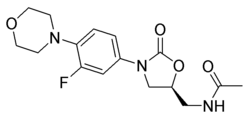Zyvox
Linezolid is a synthetic systemic antibiotic drug. more...
It was the first commercially available oxazolidinone antibiotic and is usually reserved for the treatment of serious bacterial infections where older antibiotics have failed due to antibiotic resistance. Conditions such as skin infections or nosocomial pneumonia where methicillin or penicillin resistance is found are indicators for linezolid use. Compared to the older antibiotics it is quite expensive.
The drug works by inhibiting the initiation of bacterial protein synthesis; it is the only antibiotic to work in this manner. That and its synthetic nature raised hopes that bacteria would be unable to develop resistance to it and also remove the chance of cross-resistance. (However, in 1997 Staphylococcus aureus was first identified in Japan as being resistant to linezolid.) Linezolid is effective against gram-positive pathogens, notably Enterococcus faecium, Staphylococcus aureus, Streptococcus agalactiae, Streptococcus pneumoniae, and Streptococcus pyogenes. It has almost no effect on gram-negative bacteria and is only bacteriostatic against most Enterococcus species.
The oxazolidinone class was discovered by researchers at E.I. duPont de Nemours and reported in 1987. Pharmacia Corporation developed linezolid and FDA approval was granted in April 2000. It is sold in the US under the tradename Zyvox in either tablet form, oral suspension powder, or in an inactive medium for intravenous injection.
Adverse effects
Side effects include rashes, loss of appetite, diarrhea, nausea, constipation and fever. A small number of patients will incur a severe allergic reaction, or tinnitis, or pseudomembranous colitis, or thrombocytopenia. Linezolid is a weak monoamine oxidase inhibitor (MAOI) and cannot be used with tyramine containing foods or pseudoephedrine.
Linezolid is toxic to mitochondria (probably because of the similarity of mitochondrial ribosomes to bacteria mitochondria). Signs of mitochondrial toxicity include lactic acidosis and peripheral neuropathy (Soriano et al., 2005).
Read more at Wikipedia.org



